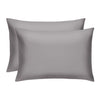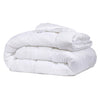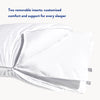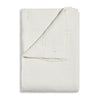The Daily Miracle
Percale vs. Sateen: What Is the Difference?
Published
December 15, 2022
Author
Bridget Reed

It’s time to pick out some new sheets! With 28 fabric types, choosing the right one can feel intimidating, but rest assured, there’s nothing to stress about. We’re here to ensure you purchase the perfect bedding — whether it be percale or sateen.
Percale and sateen are both fantastic options, but each has its pros and cons. What sets them apart is their tread counts and price — higher thread-count results in a more durable, higher-quality fabric. Percale is traditionally more affordable than sateen, but neither is a bad option. Percale is excellent if you want a high-quality comforter for a lower price tag, and sateen is fabulous if you’re truly indulgent when it comes to your bedding.
A sheet’s thread count says a lot about its overall quality; for sateen, a 500-thread count sateen weave bedding is a great rule-of-thumb, and for percale sheets, stick to 350-thread count or above.
Before you decide on percale or sateen sheets, here’s what we’ve gathered about the two fabrics.
Percale: What Is It?
During the 18th century, percale was one of the most sought-after fabrics on the market. Its tight stitching resulted in a durable and sturdy fabric.
Percale is a plain-weave, closely woven fabric. This achieves a tighter feel than other bedsheets. Percale traditionally comes in a minimum of 200 thread count and has no gloss or shine.
It can be woven of various fabrics, including cotton and polyester, and is made from carded and combed yarn.
What Does Percale Feel Like?
Its unique texture may catch you off-guard at first. Unlike sateens' smooth, silky feel, percale is soft and somewhat crunch — think of a white button-down shirt. Percale is still smooth but feels entirely different from sateen.
What Are the Pros of Percale?
Percale fabric is soft, durable, and excellent bedding material. Percale has many pros and is more affordable than sateen.
Life span
Percale lasts longer compared to the standard sheet. Its high thread-count results in a sturdy piece of fabric. Percale may be the fabric for you if you’re not keen on replacing your sheets anytime soon.
Minimal care
Percale washes excellently and is easily cared for. Unlike fabrics such as chiffon, you can machine wash your percale sheets with no worry or concern.
It ages well
You rarely hear of a fabric that gets better over time, but thanks to percale’s tight weave, it actually gets softer each wash (or the more you break it in). Percale is still plenty soft right off the shelf but will continuously loosen up and gain more flexibility.
It’s breathable
Night sweats are a common medical condition caused by various factors; some include depression, hormone imbalance, or drug or alcohol use. Sometimes, it’s just because a person is sleeping on the wrong bedding. Nobody enjoys waking up to a puddle of sweat every night, so breathable sheets are a must if you’re a hot sleeper.
Percal is one of the more breathable fabrics and comes highly suggested to anyone that’s more warm-blooded. If you suffer from night sweats, consider temperature-regulating bedding.
Comfortable feel
Having sleeping problems? Your bedding may be the culprit. That’s right, even though a great emphasis is put on the mattress (and is often blamed for lackluster sleep), your sheets can also significantly impact your sleep.
More Affordable
Don’t be fooled by percale’s soft texture, minimal care, and excellent lifespan: It’s a more affordable option than sateen.
Percale Cons
Percale has many attractive attributes, but that’s not to say it's completely flawless.
Here are a few things to keep in mind prior to your percale purchase:
Wrinkles easily
Due to its unique texture, this fabric is prone to wrinkles. But with a quick run under the hot iron, the wrinkles will be a thing of the past.
Loud noise
Percale’s texture isn’t as silent as some would like, especially if you share a bed. Percale texture makes a loud, crunching noise when touched or moved around.
Sateen: What Is It?
Sateen sheets are notorious for their silky, smooth, and luxurious feel. Its luscious texture is thanks to its sateen weave structure of four over and one under. Sateen is made with spun yarns, not filaments (polyester fibers).
The standard thread count for sateen sheets is 250 to 300, but the higher the thread count, the better. Anything around the 500 mark will feel exceptionally buttery on your skin.
Sateen weave sheets are not to be confused with satin weave; they’re two different fabrics. Sateen weave sheets are made from cotton, whereas satin is made from silk, polyester, or nylon.
Unlike percale, sateen sheets have a luminous sheen, resulting in a high-end appearance. The price of a sateen sheet set will vary from $50 to $200, with a higher thread count being more expensive. If you spot a higher thread count (350 and above) of sateen weave sheets for under $200, we suggest snagging them before it’s too late.
What Does Sateen Feel Like?
Unlike percale sheets, sateen sheets don’t require a break-in period; they’ll feel silky smooth right out of the package. Sateen is thicker and less breathable than percale, which results in an extra cozy feel, but it may not work great for hot sleepers.
Sateen is silky with a slight shine and, while thicker, may not be as durable as percale. Opt for a higher thread count to ensure longevity.
What Are the Pros of Sateen?
Here’s what makes sateen sheets so wonderful (and highly recommended)
Wrinkle resistant
Percale is notorious for its wrinkles and often leaves your room looking drab or messy. Luckily, sateen sheets are wrinkle-resistant, which results in a premium appearance.
Luxurious feel
Sateen has a more attractive, softer feel. Sateen has the silky appearance that percale lacks.
Suitable for sensitive skin
If you’re prone to breakouts, rashes, or skin irritation, finding sheets that don’t bother your skin can pose a challenge. For sensitive skin, opt for gentile materials that will keep the bacteria at bay. Self-cleaning, antibacterial sateen sheets will ensure your skin is met with the softest material each night.
Upscale look
Sateen sheets will provide a more elegant appearance compared to standard sheets. Treat yourself this holiday season; invest in premier sateen bedding.
Sateen Cons
Sateen has a long list of pros, but there are (possible) downsides to consider before your purchase.
Prone to pilling
Sateen sheets' luscious feel results in a more delicate surface than percale. Too much friction or a non-gentle wash cycle may be the culprit behind sateen pilling. While sateen is more prone to pilling than percale, if you invest in a high-quality sheet, it should be an issue regardless.
Miracle Tip: Wash your sateen bedding alone for an optimal lifespan.
Less breathable
While sateen sheets are traditionally less breathable than percale, this can be easily fixed by purchasing a temperature-regulating sateen sheet set. You can have the positive attributes of sateen sheets without the unwanted heat retention affecting your sleep.
Hello, New Bedding
There’s something especially exciting about purchasing new bedding. Percale and sateen sheets have many pros and few cons, and while some people prefer their sateen sheets, others insist on keeping their bedding percale.
The main difference is that percale is more affordable than sateen, but both are great options. Whether you choose percale or sateen, you’ll surely sleep like a baby.
Sources:
Night sweats Causes | Mayo Clinic


























